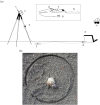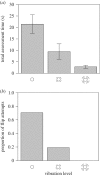Get off my back: vibrational assessment of homeowner strength
- PMID: 30940018
- PMCID: PMC6501369
- DOI: 10.1098/rsbl.2018.0819
Get off my back: vibrational assessment of homeowner strength
Abstract
Animals may use a variety of sensory modalities to assess ownership and resource-holding potential (RHP). However, few studies have experimentally tested whether animals can assess these key variables through a purely vibrational modality, exclusively involving substrate-borne vibrations. Here we studied social terrestrial hermit crabs ( Coenobita compressus), where competitors assess homeowners by climbing on top of a solid external structure-an architecturally remodelled shell home, inside of which the owner then produces vibrations. In the field, we used a miniature vibratory device, hidden within an empty shell, to experimentally simulate a 'phantom owner', with variable amplitudes of vibration representing different levels of homeowner strength. We found that assessors could use these vibrations to deduce the owner's RHP: for strong vibrations (indicative of a high RHP owner) assessors were least likely to escalate the conflict; for weak vibrations (indicative of a low RHP owner) assessors showed intermediate escalation; and in the absence of vibration (indicative of an extremely weak or absent owner) assessors were most likely to escalate. These results reveal that animals can assess homeowner strength based solely on substrate vibrations, thereby making important decisions about whether to escalate social conflicts over property.
Keywords: property ownership; resource-holding potential; shells; signals and cues; sociality; vibration.
Conflict of interest statement
We declare we have no competing interests.
Figures


Similar articles
-
Substrate-borne vibration and sound production by the land hermit crab Coenobita compressus during social interactions.J Acoust Soc Am. 2021 May;149(5):3261. doi: 10.1121/10.0004988. J Acoust Soc Am. 2021. PMID: 34241129
-
Social conquest of land: Sea-to-land changes in shell architecture and body morphology, with consequences for social evolution.Arthropod Struct Dev. 2021 Jul;63:101064. doi: 10.1016/j.asd.2021.101064. Epub 2021 Jun 4. Arthropod Struct Dev. 2021. PMID: 34098322
-
Shell resource partitioning as a mechanism of coexistence in two co-occurring terrestrial hermit crab species.BMC Ecol. 2020 Jan 16;20(1):1. doi: 10.1186/s12898-019-0268-2. BMC Ecol. 2020. PMID: 31941480 Free PMC article.
-
Hermit crabs, shells, and sentience.Anim Cogn. 2022 Oct;25(5):1241-1257. doi: 10.1007/s10071-022-01607-7. Epub 2022 Feb 23. Anim Cogn. 2022. PMID: 35199235 Review.
-
Manipulating behaviour with substrate-borne vibrations--potential for insect pest control.Pest Manag Sci. 2015 Jan;71(1):15-23. doi: 10.1002/ps.3848. Epub 2014 Jul 16. Pest Manag Sci. 2015. PMID: 24962656 Review.
Cited by
-
Finding a home in the noise: cross-modal impact of anthropogenic vibration on animal search behaviour.Biol Open. 2019 Jul 10;8(7):bio041988. doi: 10.1242/bio.041988. Biol Open. 2019. PMID: 31292133 Free PMC article.
-
Egg-Clutch Biomechanics Affect Escape-Hatching Behavior and Performance.Integr Org Biol. 2024 Mar 13;6(1):obae006. doi: 10.1093/iob/obae006. eCollection 2024. Integr Org Biol. 2024. PMID: 38585155 Free PMC article.
References
-
- Stevens M. 2013. Sensory ecology, behaviour, and evolution. New York, NY: Oxford University Press.
-
- Bradbury JW, Vehrencamp SL. 2011. Principles of animal communication, 2nd edn. Sunderland, MA: Sinauer Associates.
-
- Strassmann JE, Queller DC. 2014. Privatization and property in biology. Anim. Behav. 92, 305–311. (10.1016/j.anbehav.2014.02.011) - DOI
-
- Arnott G, Elwood RW. 2009. Assessment of fighting ability in animal contests. Anim. Behav. 77, 991–1004. (10.1016/j.anbehav.2009.02.010) - DOI
Publication types
MeSH terms
Associated data
LinkOut - more resources
Full Text Sources
Other Literature Sources

